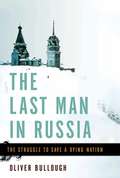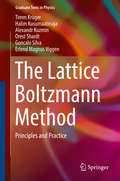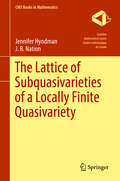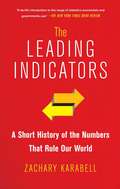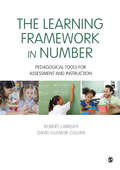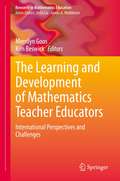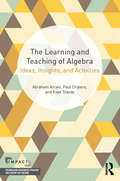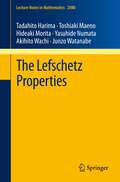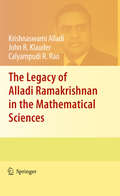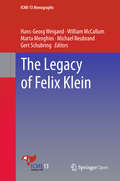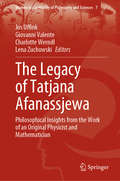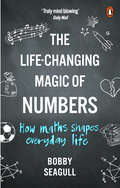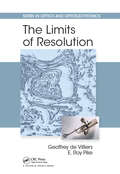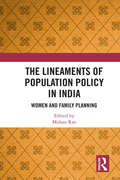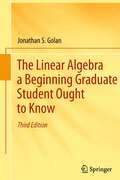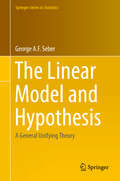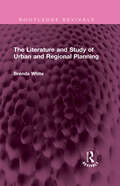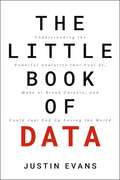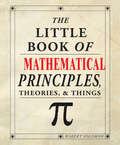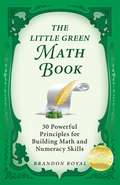- Table View
- List View
The Last Man in Russia: The Struggle to Save a Dying Nation
by Oliver BulloughRussia is dying from within. Oligarchs and oil barons may still dominate international news coverage, but their prosperity masks a deep-rooted demographic tragedy. Faced with staggering population decline--and near-certain economic collapse--driven by toxic levels of alcohol abuse, Russia is also battling a deeper sickness: a spiritual one, born out of the country’s long totalitarian experiment. In The Last Man in Russia, award-winning journalist Oliver Bullough uses the tale of a lone priest to give life to this national crisis. Father Dmitry Dudko, a dissident Orthodox Christian, was thrown into a Stalinist labor camp for writing poetry. Undaunted, on his release in the mid-1950s he began to preach to congregations across Russia with little concern for his own safety. At a time when the Soviet government denied its subjects the prospect of advancement, and turned friend against friend and brother against brother, Dudko urged his followers to cling to hope. He maintained a circle of sacred trust at the heart of one of history’s most deceitful systems. But as Bullough reveals, this courageous group of believers was eventually shattered by a terrible act of betrayal--one that exposes the full extent of the Communist tragedy. Still, Dudko’s dream endures. Although most Russians have forgotten the man himself, the embers of hope that survived the darkness are once more beginning to burn. Leading readers from a churchyard in Moscow to the snow-blanketed ghost towns of rural Russia, and from the forgotten graves of Stalin’s victims to a rock festival in an old gulag camp, The Last Man in Russia is at once a travelogue, a sociological study, a biography, and a cri de coeur for a dying nation--one that, Bullough shows, might yet be saved.
The Lattice Boltzmann Method
by Timm Krüger Halim Kusumaatmaja Alexandr Kuzmin Orest Shardt Goncalo Silva Erlend Magnus ViggenThis book is an introduction to the theory, practice, and implementation of the Lattice Boltzmann (LB) method, a powerful computational fluid dynamics method that is steadily gaining attention due to its simplicity, scalability, extensibility, and simple handling of complex geometries. The book contains chapters on the method's background, fundamental theory, advanced extensions, and implementation. To aid beginners, the most essential paragraphs in each chapter are highlighted, and the introductory chapters on various LB topics are front-loaded with special "in a nutshell" sections that condense the chapter's most important practical results. Together, these sections can be used to quickly get up and running with the method. Exercises are integrated throughout the text, and frequently asked questions about the method are dealt with in a special section at the beginning. In the book itself and through its web page, readers can find example codes showing how the LB method can be implemented efficiently on a variety of hardware platforms, including multi-core processors, clusters, and graphics processing units. Students and scientists learning and using the LB method will appreciate the wealth of clearly presented and structured information in this volume.
The Lattice of Subquasivarieties of a Locally Finite Quasivariety (CMS Books in Mathematics)
by Jennifer Hyndman J. B. NationThis book discusses the ways in which the algebras in a locally finite quasivariety determine its lattice of subquasivarieties. The book starts with a clear and comprehensive presentation of the basic structure theory of quasivariety lattices, and then develops new methods and algorithms for their analysis. Particular attention is paid to the role of quasicritical algebras. The methods are illustrated by applying them to quasivarieties of abelian groups, modular lattices, unary algebras and pure relational structures. An appendix gives an overview of the theory of quasivarieties. Extensive references to the literature are provided throughout.
The Leading Indicators: A Short History of the Numbers That Rule Our World
by Zachary KarabellHow did we come by the "leading indicators" we place such stock in? We allocate trillions of dollars and make public policy and personal decisions based upon them, but what do they really tell us?"The leading indicators" shape our lives intimately, but few of us know where these numbers come from, what they mean, or why they rule the world. GDP, inflation, unemployment, trade, and a host of averages determine whether we feel optimistic or pessimistic about the country's future and our own. They dictate whether businesses hire and invest, or fire and hunker down, whether governments spend trillions or try to reduce debt, whether individuals marry, buy a car, get a mortgage, or look for a job.Zachary Karabell tackles the history and the limitations of each of our leading indicators. The solution is not to invent new indicators, but to become less dependent on a few simple figures and tap into the data revolution. We have unparalleled power to find the information we need, but only if we let go of the outdated indicators that lead and mislead us.
The Learning Framework in Number: Pedagogical Tools for Assessment and Instruction (Math Recovery)
by Robert J Wright David Ellemor-CollinsThis book is borne out of a collaborative research project (2004-8) between Math Recovery and CEM (Catholic Education Melbourne) funded by the Australian Research Council focusing on intervention in the number learning of low-attaining students in the first five years of school. This has involved developing new pedagogical tools (PTs) for assessment, instruction and intervention including a coherent, research-based framework for understanding the key aspects of students’ developing number knowledge. It also offers guidance on innovative video-based assessment and an overview of principles of intervention instruction. This book will be a useful guide for all primary and elementary school classroom teachers and assistants, and specialist teachers, including experienced Mathematics Recovery instructors. It will also be of significant interest to teacher educators and researchers.
The Learning Framework in Number: Pedagogical Tools for Assessment and Instruction (Math Recovery)
by Robert J Wright David Ellemor-CollinsThis book is borne out of a collaborative research project (2004-8) between Math Recovery and CEM (Catholic Education Melbourne) funded by the Australian Research Council focusing on intervention in the number learning of low-attaining students in the first five years of school. This has involved developing new pedagogical tools (PTs) for assessment, instruction and intervention including a coherent, research-based framework for understanding the key aspects of students’ developing number knowledge. It also offers guidance on innovative video-based assessment and an overview of principles of intervention instruction. This book will be a useful guide for all primary and elementary school classroom teachers and assistants, and specialist teachers, including experienced Mathematics Recovery instructors. It will also be of significant interest to teacher educators and researchers.
The Learning and Development of Mathematics Teacher Educators: International Perspectives and Challenges (Research in Mathematics Education)
by Merrilyn Goos Kim BeswickResearch in mathematics teacher education as a distinctive field of inquiry has grown substantially over the past 10-15 years. Within this field there is emerging interest in how mathematics teacher educators (MTEs) themselves learn and develop. Until recently there were few published studies on this topic, and the processes by which mathematics teacher educators learn, and the forms of knowledge they require for effective practice, had not been systematically investigated. However, researchers in mathematics education are now beginning to investigate the development of MTE expertise and associated issues. This volume draws on the latest research and thinking in this area is therefore timely to stimulate future development and directions. It will survey the emerging field of inquiry in mathematics education, combining the work of established scholars with perspectives of newcomers to the field, with the aim of influencing development of the field, invite cross-cultural comparisons in becoming a mathematics teacher educator by highlighting issues in the development of MTEs in different countries, and examine the roles of both mathematics educators and mathematicians in preparing future teachers of mathematics. The primary audience will be university-based mathematics teacher educators and MTE researchers, and postgraduate research students who are seeking academic careers as MTEs. Additional interest may come from teacher educators in disciplines other than mathematics, and education policy makers responsible for accreditation and quality control of initial teacher education programs.
The Learning and Teaching of Algebra: Ideas, Insights and Activities (IMPACT: Interweaving Mathematics Pedagogy and Content for Teaching #8)
by Kaye Stacey Paul Drijvers Abraham ArcaviIMPACT (Interweaving Mathematics Pedagogy and Content for Teaching) is an exciting new series of texts for teacher education which aims to advance the learning and teaching of mathematics by integrating mathematics content with the broader research and theoretical base of mathematics education. The Learning and Teaching of Algebra provides a pedagogical framework for the teaching and learning of algebra grounded in theory and research. Areas covered include: • Algebra: Setting the Scene • Some Lessons From History • Seeing Algebra Through the Eyes of a Learner • Emphases in Algebra Teaching • Algebra Education in the Digital Era This guide will be essential reading for trainee and qualified teachers of mathematics, graduate students, curriculum developers, researchers and all those who are interested in the "problématique" of teaching and learning algebra. It allows you to get involved in the wealth of knowledge that teachers can draw upon to assist learners, helping you gain the insights that mastering algebra provides.
The Lefschetz Properties
by Junzo Watanabe Yasuhide Numata Toshiaki Maeno Hideaki Morita Akihito Wachi Tadahito HarimaThis is a monograph which collects basic techniques, major results and interesting applications of Lefschetz properties of Artinian algebras. The origin of the Lefschetz properties of Artinian algebras is the Hard Lefschetz Theorem, which is a major result in algebraic geometry. However, for the last two decades, numerous applications of the Lefschetz properties to other areas of mathematics have been found, as a result of which the theory of the Lefschetz properties is now of great interest in its own right. It also has ties to other areas, including combinatorics, algebraic geometry, algebraic topology, commutative algebra and representation theory. The connections between the Lefschetz property and other areas of mathematics are not only diverse, but sometimes quite surprising, e.g. its ties to the Schur-Weyl duality. This is the first book solely devoted to the Lefschetz properties and is the first attempt to treat those properties systematically.
The Legacy of Alladi Ramakrishnan in the Mathematical Sciences
by Krishnaswami Alladi John R. Klauder Calyampudi R. RaoIn the spirit of Alladi Ramakrishnan's profound interest and contributions to three fields of science -- Mathematics, Statistics, and Physics -- this volume contains invited surveys and research articles from prominent members of these communities who also knew Ramakrishnan personally and greatly respected his influence in these areas of science. Historical photos, telegrams, and biographical narratives of Alladi Ramakrishnan's illustrious career of special interest are included as well.
The Legacy of Felix Klein (ICME-13 Monographs)
by Michael Neubrand Hans-Georg Weigand Gert Schubring William McCallum Marta MenghiniThis open access book provides an overview of Felix Klein’s ideas, highlighting developments in university teaching and school mathematics related to Klein’s thoughts, stemming from the last century. It discusses the meaning, importance and the legacy of Klein’s ideas today and in the future, within an international, global context. Presenting extended versions of the talks at the Thematic Afternoon at ICME-13, the book shows that many of Klein’s ideas can be reinterpreted in the context of the current situation, and offers tips and advice for dealing with current problems in teacher education and teaching mathematics in secondary schools. It proves that old ideas are timeless, but that it takes competent, committed and assertive individuals to bring these ideas to life. Throughout his professional life, Felix Klein emphasised the importance of reflecting upon mathematics teaching and learning from both a mathematical and a psychological or educational point of view. He also strongly promoted the modernisation of mathematics in the classroom, and developed ideas on university lectures for student teachers, which he later consolidated at the beginning of the last century in the three books on elementary mathematics from a higher standpoint.
The Legacy of Tatjana Afanassjewa: Philosophical Insights from the Work of an Original Physicist and Mathematician (Women in the History of Philosophy and Sciences #7)
by Jos Uffink Giovanni Valente Charlotte Werndl Lena ZuchowskiThis book presents a collection of essays that explore the life and works of Tatjana Afanassjewa (1876–1964), a Russian–Dutch physicist–mathematician. Readers will discover a scientist whose work on the foundations of thermodynamics significantly influenced the field itself as well as the philosophy of physics. This book highlights the philosophical consequences of her work in physics and mathematics and discusses historical aspects of her writings on the foundations of physics. In addition, it features English translations and critical reviews of key selections from her texts.First and foremost, the book highlights the numerous contributions that Afanassjewa made to the field. In particular, the authors examine her work on the foundations of thermodynamics and statistical physics, starting in the 1920s and extending to 1956, well after the untimely death of her husband in 1933. They also explore her almost entirely forgotten work on the didactics of mathematics. In addition, they discuss her influential collaboration with her husband, the Austrian physicist Paul Ehrenfest (1880–1933).The portrait that emerges is that of a highly original physicist and mathematician, whose legacy continues to influence scientists and philosophers today and whose lesser-known works deserve more attention than they have received. Readers will find a rich body of work that continues to this day to yield insights into the foundations of physics and mathematics.
The Lemonade War (Into Reading, Trade Book #2)
by Jacqueline DaviesNIMAC-sourced textbook <p><p> Fourth-grader Evan Treski is people-smart. He’s good at talking with people, even grownups. His younger sister, Jessie, on the other hand, is math-smart, but not especially good with people. So when the siblings’ lemonade stand war begins, there really is no telling who will win—or even if their fight will ever end. Brimming with savvy marketing tips for making money at any business, definitions of business terms, charts, diagrams, and even math problems, this fresh, funny, emotionally charged novel subtly explores how arguments can escalate beyond anyone’s intent.
The Life-Changing Magic of Numbers
by Bobby SeagullIf you found maths lessons at school irrelevant and boring, that’s because you didn’t have a teacher like Bobby Seagull.***As seen on Monkman & Seagull's Genius Guide to Britain*** Long before his rise to cult fandom on University Challenge, Bobby Seagull was obsessed with numbers. They were the keys that unlocked the randomness of football results, the beauty of art and the best way to get things done. In his absorbing book, Bobby tells the story of his life through numbers and shows the incredible ways maths can make sense of the world around us. From magic shows to rap lyrics, from hobbies to outer space, from fitness to food – Bobby’s infectious enthusiasm for numbers will change how you think about almost everything. Told through fascinating stories and insights from Bobby’s life, and with head-scratching puzzles in every chapter, you’ll never look at numbers the same way again.
The Limits of Resolution (Series in Optics and Optoelectronics)
by Geoffrey de Villiers E. Roy Pike"This beautiful book can be read as a novel presenting carefully our quest to get more and more information from our observations and measurements. Its authors are particularly good at relating it." --Pierre C. Sabatier "This is a unique text - a labor of love pulling together for the first time the remarkably large array of mathematical and statistical techniques used for analysis of resolution in many systems of importance today – optical, acoustical, radar, etc…. I believe it will find widespread use and value." --Dr. Robert G.W. Brown, Chief Executive Officer, American Institute of Physics "The mix of physics and mathematics is a unique feature of this book which can be basic not only for PhD students but also for researchers in the area of computational imaging." --Mario Bertero, Professor, University of Geneva "a tour-de-force covering aspects of history, mathematical theory and practical applications. The authors provide a penetrating insight into the often confused topic of resolution and in doing offer a unifying approach to the subject that is applicable not only to traditional optical systems but also modern day, computer-based systems such as radar and RF communications." --Prof. Ian Proudler, Loughborough University "a ‘must have’ for anyone interested in imaging and the spatial resolution of images. This book provides detailed and very readable account of resolution in imaging and organizes the recent history of the subject in excellent fashion.… I strongly recommend it." --Michael A. Fiddy, Professor, University of North Carolina at Charlotte This book brings together the concept of resolution, which limits what we can determine about our physical world, with the theory of linear inverse problems, emphasizing practical applications. The book focuses on methods for solving illposed problems that do not have unique stable solutions. After introducing basic concepts, the contents address problems with "continuous" data in detail before turning to cases of discrete data sets. As one of the unifying principles of the text, the authors explain how non-uniqueness is a feature of measurement problems in science where precision and resolution is essentially always limited by some kind of noise.
The Limits to Growth: A Report for the Club of Rome's Project on the Predicament of Mankind
by Donella H. Meadows Dennis L. Meadows Jorgen Randers William W. Behrens IIIA report from The Club of Rome, an informal organization that has been aptly described as an "invisible college." Its purposes are to foster understanding of the varied but interdependent components-- economic, political, natural, and social-- that make up the global system in which we all live; to bring that new understanding to the attention of policy-makers and the public worldwide; and in this way to promote new policy initiatives and action. This report caused much controversy when it was published.
The Lineaments of Population Policy in India: Women and Family Planning
by Mohan RaoIndia is the first country in the world to have an official programme for family planning that commenced in 1952. It has also seen a strong women’s movement to assert reproductive and contraceptive rights. This book brings to the fore several contestations and negotiations between public policy and the women’s movement in India. The comprehensive volume puts together key documents from archival records and authoritative sources, and traces the contours that have marked and defined the population policy in India as well as rights issues for women. <P><P>A major intervention in the field, this book will be indispensable for scholars and researchers in public policy, public health, demography, gender studies, social policy, development studies, sociology, social justice, human rights, politics and those interested in the study of modern India.
The Linear Algebra a Beginning Graduate Student Ought to Know
by Jonathan S. GolanLinear algebra is a living, active branch of mathematics which is central to almost all other areas of mathematics, both pure and applied, as well as to computer science, to the physical, biological, and social sciences, and to engineering. It encompasses an extensive corpus of theoretical results as well as a large and rapidly-growing body of computational techniques. Unfortunately, in the past decade, the content of linear algebra courses required to complete an undergraduate degree in mathematics has been depleted to the extent that they fail to provide a sufficient theoretical or computational background. Students are not only less able to formulate or even follow mathematical proofs, they are also less able to understand the mathematics of the numerical algorithms they need for applications. Certainly, the material presented in the average undergraduate course is insufficient for graduate study. This book is intended to fill the gap which has developed by providing enough theoretical and computational material to allow the advanced undergraduate or beginning graduate student to overcome this deficiency and be able to work independently or in advanced courses. The book is intended to be used either as a self-study guide, a textbook for a course in advanced linear algebra, or as a reference book. It is also designed to prepare a student for the linear algebra portion of prelim exams or PhD qualifying exams. The volume is self-contained to the extent that it does not assume any previous formal knowledge of linear algebra, though the reader is assumed to have been exposed, at least informally, to some of the basic ideas and techniques, such as manipulation of small matrices and the solution of small systems of linear equations over the real numbers. More importantly, it assumes a seriousness of purpose, considerable motivation, and a modicum of mathematical sophistication on the part of the reader. In the latest edition, new major theorems have been added, as well as many new examples. There are over 130 additional exercises and many of the previous exercises have been revised or rewritten. In addition, a large number of additional biographical notes and thumbnail portraits of mathematicians have been included.
The Linear Model and Hypothesis
by George SeberThis book provides a concise and integrated overview of hypothesis testing in four important subject areas, namely linear and nonlinear models, multivariate analysis, and large sample theory. The approach used is a geometrical one based on the concept of projections and their associated idempotent matrices, thus largely avoiding the need to involvematrix ranks. It is shown that all the hypotheses encountered are either linear or asymptotically linear, and that all the underlying models used are either exactly or asymptotically linear normal models. This equivalence can be used, for example, to extend the concept of orthogonality to other models in the analysis of variance, and to show that the asymptotic equivalence of the likelihood ratio, Wald, and Score (Lagrange Multiplier) hypothesis tests generally applies.
The Literature and Study of Urban and Regional Planning (Routledge Revivals)
by Brenda WhiteFirst published in 1974, The Literature and Study of Urban and Regional Planning discusses the processes of spatial planning and the range of subject knowledge which is required to contribute to it. It describes the physical forms in which the literature relating to spatial planning is usually presented and the ways in which this literature is made available in different types of organization. The author gives details of the most useful libraries whose facilities are available to students, and of the research which is being undertaken into the principal problems of planning information. The second part of the book consists of a subject bibliography, divided for ease of reference into twenty-six sections each concerned with a component part of spatial planning and containing annotated references to books, official publications, developmental plans, legislation, and other material. This book will be of interest to students of sociology and urban studies.
The Little Book of Data: Understanding the Powerful Analytics that Fuel AI, Make or Break Careers, and Could Just End Up Saving the World
by Justin EvansData is not about number crunching. It&’s about ideas. And when used properly (read: ethically), it is the problem solver of our time.Yet many savvy people seem to be in data denial: they don&’t think they need to understand data, or it&’s too complicated, or worse, using it is somehow unethical. Yet as data and AI (just an accelerated way to put data to work) move to the center of professional and civic life, every professional and citizen needs to harness this power.In The Little Book of Data, each chapter illustrates one of the core principles of solving problems with data by featuring an expert who has solved a big problem with data—from the entrepreneur creating a &“loneliness score&” to the epidemiologist trying to save lives by finding disease &“hotspots.&”The stories are told in a fast-moving, vivid, sometimes comic style, and cover a wide frame of reference from adtech to climate tech, the bubonic plague, tiny submarines, genomics, railroads, bond ratings, and meat grading. (That&’s right. Meat.)Along the way Evans injects lessons from his own career journey and offers practical thought-starters for readers to apply to their own organizations.By reading The Little Book of Data, you will achieve the fluency to apply your data superpowers to your own mission and challenges—and you will have fun along the way.You will be, in other words, a data person.
The Little Book of Mathematical Principles, Theories & Things
by Robert SolomonThis little book makes serious math simple—with more than 120 laws, theorems, paradoxes, and more explained in jargon-free terms.The Little Book of Mathematical Principles provides simple, clear explanations for the principles, equations, paradoxes, laws, and theorems that form the basis of modern mathematics. It is a refreshingly engaging tour of Fibonacci numbers, Euclid's Elements, and Zeno's paradoxes, as well as other fundamental principles such as chaos theory, game theory, and the game of life.Renowned mathematics author Dr. Robert Solomon simplifies the ancient discipline of mathematics and provides fascinating answers to intriguing questions, such as: What is the greatest pyramid?, What is a perfect number?, and Is there a theory for stacking oranges?
The Little Data Book on Gender in Africa 2012/13
by World BankThe Little Data Book on Gender in Africa 2012/13 provides a summary collection of gender statistics on Africa available in one volume. It contains 60 indicators, covering 53 African countries. Additional data may be found on the companion CD-ROM or online, covering about 1,700 indicators from 1961 to 2011. Key themes are : - Basic demographic indicators- Education- Health- Labor force and wages- Women's empowermentDesigned to provide all those interested in Africa with quick reference and a reliable set of data to monitor development programs and aid flows in the region, this is an invaluable pocket edition reference tool for analysts and policy makers who want a better understanding of the economic and social developments occurring in Africa. For free access to Africa Development Indicators online, please visit http://data. worldbank. org/data-catalog.
The Little Green Math Book: 30 Powerful Principles for Building Math and Numeracy Skills
by Brandon Royal<p>The Little Green Math Book reads like a collection of math recipes to help us blend problems, principles, and approaches in creating our own lineup of splendid math cuisine. The book's four chapters include: (1) Basic Numeracy Ingredients, (2) Wonderful Math Recipes, (3) Favorite Numeracy Dishes, and (4) Special Math Garnishments. Along with 30 of the most fundamental, recurring math principles and rules, readers will find a three-tier system to rate the difficulty level of all 100 problems – one chili (“mild”), two chilies (“hot”), and three chilies (“very hot”). <p>Fine-tune your numerical mindset with a quantitative review that serves as a refresher course and as a tool for perceiving math in a new way. Whether you’re a high school or college student, test-prep candidate, or working professional, this book’s wealth of explanations and insights makes it a perfect learning companion.</p>
The Logic Of Infinity
by Barnaby SheppardFew mathematical results capture the imagination like Georg Cantor's groundbreaking work on infinity in the late nineteenth century. This opened the door to an intricate axiomatic theory of sets which was born in the decades that followed. Written for the motivated novice, this book provides an overview of key ideas in set theory, bridging the gap between technical accounts of mathematical foundations and popular accounts of logic. Readers will learn of the formal construction of the classical number systems, from the natural numbers to the real numbers and beyond, and see how set theory has evolved to analyse such deep questions as the status of the continuum hypothesis and the axiom of choice. Remarks and digressions introduce the reader to some of the philosophical aspects of the subject and to adjacent mathematical topics. The rich, annotated bibliography encourages the dedicated reader to delve into what is now a vast literature.
